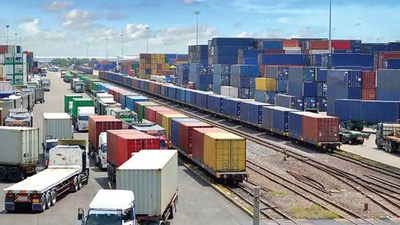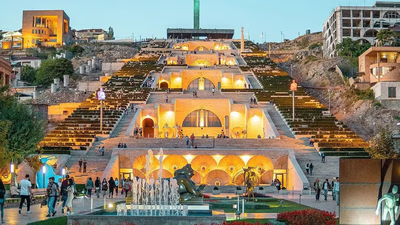
Armenia"s diverse economy includes mining and agriculture. "
Armenia's GDP is classified as an emerging market economy. In 2020, Armenia's GDP was approximately $13.6 billion, according to the International Monetary Fund (IMF). The GDP per capita was around $4,500, indicating a relatively lower income level compared to many developed nations. Armenia has a diverse economic base, with industries and services contributing significantly to its GDP. Key industries in Armenia include mining (particularly copper and molybdenum production), manufacturing (textiles, chemicals, machinery), food processing, and construction. The mining sector plays a vital role in Armenia's economy, with significant mineral resources being extracted.
Remittances from Armenians living and working abroad have been a significant source of income for the country. Many Armenians migrate to countries like Russia, the United States, and European nations in search of better economic opportunities, and they send money back to their families in Armenia. Foreign direct investment plays a role in Armenia's economic development. Investments from countries like Russia, the United States, and European nations have been made in sectors such as IT, mining, and tourism. Armenia has received financial aid and assistance from international organizations and countries to support its development projects, infrastructure improvements, and social welfare programs.
In recent decades, in addition to industry, sectors such as tourism, services, agriculture have also experienced great prosperity. Especially tourism, which in recent years has attracted many Iranians to this country. Due to its mountainous texture, Armenia has long been a place for the extraction of various minerals. For this reason, different types of mines are active in it. The most important of these mines in Armenia are gold, iron, copper, salt and some other minerals.
However, main factor of the Armenian economy can be considered energy. Armenia as Iran's northern neighbor does not have much oil, fossil fuel or gas resources. The information for the years 2018 and 2019 and is based on data from international organizations such as the International Labor Organization, the International Monetary Fund and other organizations indicated industry is the main foundation of the Armenian economy. Industrial production in this country was 4% of the total Soviet production. After Armenia's independence, the economic situation stagnated. Economic sectors are left in a state of disuse. In this country, a free market economic system is seen, which includes the aid of international organizations. As it is known, the sharp decline in 2009 was caused by the global crisis, but in 2011 the economic trend of Armenia climbed to 4.7 percent.
Armenia's income is provided through the export of goods such as diamonds and minerals such as stone, copper and metal parts. Various industries are operating in Armenia in the field of chemical production, electronic components and tools, machinery as well as food. Agriculture accounts for about 44% of the workforce in the country and industry accounts for 42% of the workforce. Evidence shows that Armenia's financial institutions and institutions are operating in good condition. Inflation has been in equilibrium in Armenia since 1998. The country has controlled its economic growth.
The services sector is an important driver of Armenia's economy, accounting for a significant portion of its GDP. Key areas within the services sector include tourism, information technology (IT) and software development, financial services, and telecommunications. Agriculture remains an important sector in Armenia, although its contribution to the overall GDP has decreased over the years. Key agricultural products include fruits, vegetables, grains, dairy products, and livestock. Agriculture is primarily carried out on small-scale family farms. Taxation is an essential source of revenue for the Armenian government. Taxes are levied on income, corporate profits, value-added goods and services, and property. The government also relies on other domestic revenue sources, such as fees and licenses.
-

Armenia"s economy, with a GDP of approximately $13. 6 billion, is classified as lower-middle-income. The country is working to enhance its trade relations and diversify its export base, which currently relies heavily on mining, agriculture, and textiles. While Armenia has made progress in the World Bank"s Ease of Doing Business Index, it still ranks lower in the Global Competitiveness Index. Key sectors include chemicals, machinery, and IT, where Armenia has gained recognition for its skilled workforce and growing startup ecosystem. However, regional challenges such as the conflict with Azerbaijan and closed borders with Turkey limit trade opportunities. Despite these hurdles, Armenia has improved its investment climate to attract foreign direct investment (FDI) through regulatory reforms and incentives. Membership in the Eurasian Economic Union (EAEU) offers access to larger markets and preferential trade agreements.
Additionally, Armenia"s Comprehensive Partnership Agreement with the EU aims to strengthen economic ties further. "
-

Armenia"s trade landscape is characterized by its rich mineral resources, particularly copper and molybdenum, which form a significant part of its exports. The country also exports agricultural products like fruits, vegetables, nuts, and dairy items, alongside textiles and jewelry. However, Armenia"s landlocked position poses challenges for expanding trade, particularly with neighboring countries like Turkey and Azerbaijan due to political tensions. This situation has created opportunities for trade with other nations, especially those in the Eurasian Union that enjoy preferential trading terms. Russia stands out as Armenia"s largest trading partner, accounting for nearly 27% of its trade volume. The relationship is bolstered by cultural ties and the benefits of the Eurasian Economic Union. Other notable partners include Switzerland, Bulgaria, Iraq, the Netherlands, China, and Iran. While Armenia imports a variety of goods including energy resources and machinery to support its economy, it often faces a trade deficit where imports surpass exports.
This imbalance necessitates reliance on remittances and foreign investments to sustain economic growth. "
-

Armenia"s economy is classified as an emerging market, with a GDP of approximately $13. 6 billion in 2020. The GDP per capita stands at around $4,500, reflecting lower income levels compared to developed nations. Key sectors include mining, manufacturing, food processing, and construction, with mining being particularly significant due to the country"s rich mineral resources. Remittances from Armenians abroad contribute substantially to national income. Foreign direct investment from countries like Russia and the U. S. supports sectors such as IT and tourism.
Despite challenges post-independence, Armenia has seen growth in various industries, including tourism which attracts visitors from neighboring Iran. The agricultural sector employs about 44% of the workforce but has seen a decline in its GDP contribution over time. The services sector is also vital, encompassing IT, financial services, and telecommunications. Armenia"s economic stability is supported by controlled inflation since 1998 and a free market system aided by international organizations. Taxation on income and corporate profits serves as a key revenue source for the government. "
-

Armenia"s primary trading partner is Russia, which supplies a significant portion of its imports, including natural gas, petroleum products, and machinery. As a member of the Eurasian Economic Union (EAEU), Armenia benefits from preferential trade agreements with Russia. China has emerged as an increasingly vital partner, providing machinery, electronics, textiles, and raw materials that support Armenia"s manufacturing and retail sectors. Germany is another key player in Armenia"s import market, known for high-quality machinery and industrial equipment. Iran also plays a crucial role by supplying energy resources and various consumer goods. The European Union (EU) has strengthened its ties with Armenia through the Comprehensive and Enhanced Partnership Agreement (CEPA), focusing on mutual interests such as economic development and reform support. Despite political tensions with Turkey, some trade continues in construction materials and textiles. The United States contributes to Armenia"s imports through technology and pharmaceuticals. Overall, Armenia maintains diverse trade relations with multiple countries to meet its import needs.
-

Armenia, a landlocked country in the South Caucasus, is bordered by Turkey, Georgia, Azerbaijan, and Iran. Its geography significantly impacts its political and economic relations. The ongoing territorial conflict with Azerbaijan over Nagorno-Karabakh has created a complex relationship, exacerbated by a closed border. Armenia maintains generally positive ties with Georgia, collaborating on various projects despite occasional tensions. Relations with Iran are historically friendly, providing Armenia with vital trade routes. The country is divided into three regions: Greater Armenia, Lesser Armenia, and New Armenia. Politically, Armenia operates as a democratic republic with a National Assembly comprising 131 seats. The political landscape has evolved over time, reflecting changes in governance and public sentiment.
Historical conflicts and geopolitical interests shape Armenia"s interactions with its neighbors, particularly with Turkey due to the contentious issue of the Armenian Genocide. Diplomatic relations remain strained as borders have been closed since 1993. "
-

Armenia"s trade landscape is characterized by strong ties with Russia, China, and the EU, particularly Germany. As a member of the Eurasian Economic Union (EAEU), Armenia benefits from preferential trade agreements with Russia, importing natural gas, machinery, and consumer goods. China has emerged as a vital partner, supplying machinery and textiles that support Armenia"s manufacturing and retail sectors. The EU also plays a significant role in Armenia"s imports, with countries like Germany and Italy providing essential goods. Additionally, Armenia maintains trade relations with nations such as Ukraine, South Korea, and India. The country"s economic growth is bolstered by its focus on industrial development and agricultural products. Despite political tensions with Turkey, some trade continues in construction materials and textiles. The United States has become increasingly important for technology and pharmaceuticals.
Overall, Armenia"s strategic partnerships enhance its economic prospects while fostering regional trade dynamics. "






